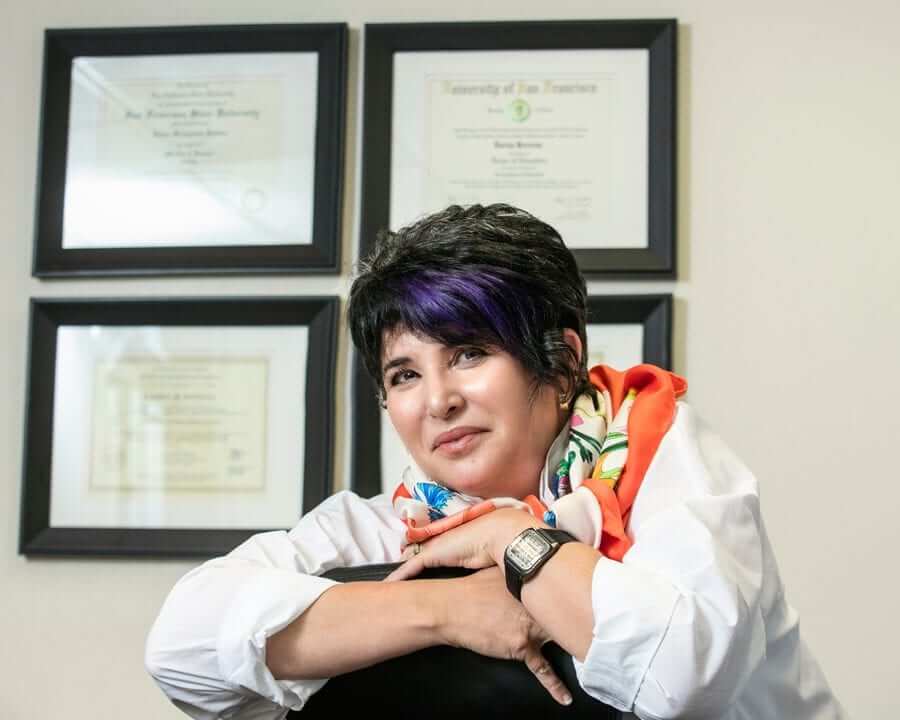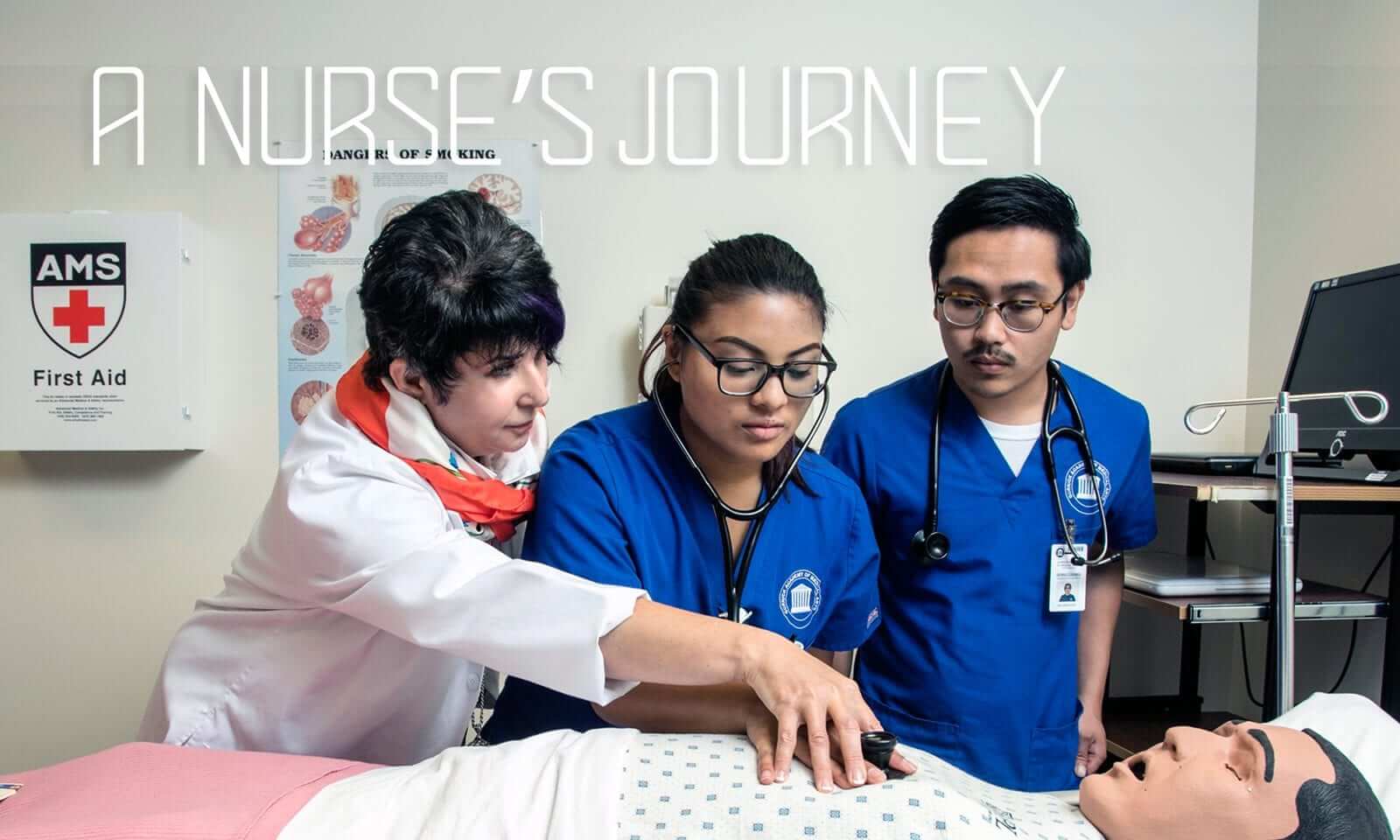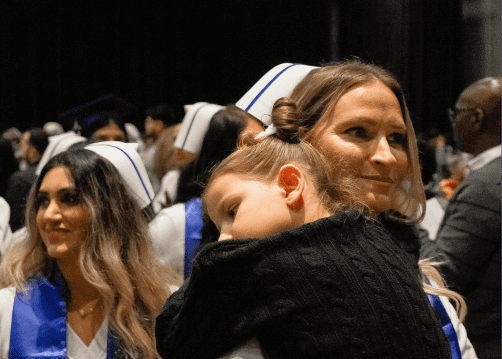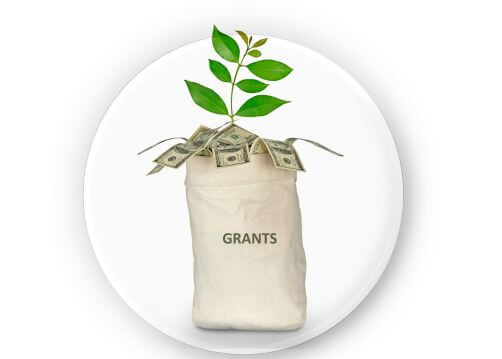A Nurse’s Journey: For A Russian Émigré, Education Opens Doors
Date: May 13, 2021
Meet Gurnick Academy of Medical Arts’ Chief Academic Officer, Dr. Larisa Revzina
The restrooms at Anchorage International Airport were immaculate, with ample supplies of soap and paper towels. That was Larisa Revzina’s first impression of the United States on March 3, 1993, a day indelibly etched in her memory, when she changed planes in Alaska on her emigration journey from Russia to the Bay Area. Later that day, a blooming magnolia tree and glistening swimming pool greeted her at the Palo Alto apartment that relatives had rented for her family, a stark contrast to the frigid, gray Moscow March she’d left behind. Inside the unfurnished apartment, she found a mattress on the floor, a refrigerator full of food, and a dishwasher (a device she’d never seen before) stocked with detergent—provisions kindly donated by members of her aunt’s synagogue.

Ted Stevens Anchorage International Airport (ANC)
“I cried because I thought, gosh, it’s a spotless country, its beautiful surroundings, and it’s excellent people,” she says, animated with the emotions of the day more than 20 years later. “This is absolutely my country.” Revzina and her family—including daughter Julia, then 10, and husband Lev—were part of a wave of Russian-Jewish emigrants in the 1990s admitted to the United States as political refugees due to overt, institutionalized anti-Semitism in the former USSR. “Filthy, inferior, no food, nothing” is how Revzina sums up the Yeltsin-era Russia she left behind. In addition to empty store shelves, there were limited opportunities, particularly for Jews, who were kept out of more upscale professions like medicine by being excluded from those university training programs. Revzina, who felt called to the medical arena, studied civil engineering and worked as a researcher until her U.S. journey began.
“I cried because I thought, gosh, it’s a very clean country, its beautiful surroundings and its excellent people,” she says, animated with the emotions of the day more than 20 years later. “This is absolutely my country.”
Revzina embraced her American life, and a success story unfolded. She earned her M.S. in nursing science at S.F. State and returned to school for her nurse practitioner certificate. After several years of clinical practice and some teaching in S.F. State’s nursing program, she co-founded the Gurnick Academy of Medical Arts, a nationally accredited professional training school where she is currently the chief academic officer. Her resume suggests a straight line to success, but the reality was a meandering path of struggle, poverty, and a particular penchant for turning failures into opportunities.
Navigating an Educational Maze
As a new arrival, Revzina had neither the language nor the money to attend medical school. So, after a few months of English lessons arranged through the local Jewish center, she enrolled in Foothill College, having heard through the Russian-immigrant community that dental hygienists earned a good living (`$30 an hour—a million dollars!’ she thought at the time). She slowly made her way through a maze of prerequisites and unclear outcomes, only to miss the cut for limited internship slots by just one place on the list. She was crushed. “You cannot imagine the number of tears and screaming and crying,” she said of watching three years of struggle amount to “no job, nothing.”
But the effort would amount to something, after all. A friend from the dental program encouraged Revzina to look into nursing. She found S.F. State’s Generic Master’s Program in Nursing Science, which did not require applicants’ undergraduate degrees to be related to medicine. There were still prerequisites, but with her engineering degree and her health-related Foothill coursework, she easily qualified.
Day One at S.F. State set a lasting tone. Patricia Hess, a now-retired professor, did a role-playing exercise, assigning students to don doctor, nurse, and patient roles. With her choppy English and the social chasm between her and the other students—well into her 30s by now, she was the only older student—Revzina tried to hide. But Hess wouldn’t allow it. “She said to me, ‘You’re going to be a doctor,’” and made Revzina stand her ground in the exercise. It was a pivotal moment; Hess’s refusal to let her disappear forced Revzina to own her education and imagine a promising future.
Years later, when Revzina earned her doctorate in education from the University of San Francisco, she made one of the first calls to her former mentor. “Dr. Hess? This is Dr. Revzina!” she belly-laughs, recounting the moment.

Dr. Larisa Revzina, Chief Academic Officer at Gurnick Academy of Medical Arts
Karen Johnson-Brennan, now an emeritus professor of nursing, is also in Revzina’s pantheon of influential S.F. State teachers—for the dubious distinction of issuing the struggling Russian student her first D on a medicine-surgery test. Revzina marched into Johnson-Brennan’s office to seek sympathy for her special language challenges, work, and money. “Who do you want to be in life?” she recalls Johnson-Brennan asking her, not buying into Revzina’s so-called predicament. “Do you want to be a poor Russian immigrant, or do you want to be an American nurse?” She sent Revzina back home to study.
“She gave me the outstanding lesson in life,” Revzina says of Johnson-Brennan, one she took to heart. Revzina studied harder, did well on her next test, and established a foundational no-excuses attitude that persists today. She says her S.F. State teachers gave her everything. “Not a lot. Everything!” she reiterates.
“We talked many a time about strategies for improvement, which she diligently worked on,” Johnson-Brennan says of the Russian student who had trouble with exams. “She always had a positive, ‘Let’s do this’ attitude.” Both Hess and Johnson-Brennan became professional collaborators, first at S.F. State’s School of Nursing, where Rezvina was an adjunct faculty member for a time. Later at Gurnick, doing curriculum development and part-time teaching. “She never fails to treat me as a friend and mentor rather than an employee of the Academy,” Johnson-Brennan says of their ongoing relationship. “She is one of the most dynamic, entrepreneurial women I have ever met.”
A Passion for Nursing
Gurnick’s humble birth story is a product of that entrepreneurialism. When Revzina’s nursing job changed to part-time, once again, she needed money. Drumming up an opportunity, she set up an informational interview at a tiny medical training school. Her interviewer didn’t have a job for her, but he had some ideas on expanding on the medical-education model and paid her a small consulting fee, which led to a business partnership. Their big break came a year later when a change in the law required phlebotomists—the technicians who draw blood—to be licensed at an official school. She designed the curriculum and filed the paperwork. Five campuses, twelve nursing and imaging programs, and thousands of alumni later, Revzina says her partner enjoys joking that the $1,200 consulting fee was the best investment he made.
Thinking back to her confusing community college experience, Revzina says Gurnick’s aim was clarity. “It’s very straightforward: These are the courses you have to take; this is the certification or licensing you earn,” she says. From phlebotomy, they branched out to train vocational nurses and medical assistants, imaging technicians, physical therapy assistants, and—coming full circle—dental assistants. Last year they reached a new milestone, graduating their first baccalaureate class in nursing.
As she marvels at her opportunities—and those of her daughter, who studied at two top universities and is now a senior manager at PayPal—Revzina wonders if people born here don’t understand how lucky they are. Back at Foothill, she cleaned houses to pay tuition. “I hated cleaning toilets. Awful. Horrible,” she says. Yet she still keeps a list of chores a client once left her, revealing both humility and a boundless appreciation for having fulfilled that early calling to medicine. “I don’t have hobbies. Work is my hobby,” she says.
“Nursing is one of the best professions. You can be a vocational nurse with no degree whatsoever. With a degree, you can climb the ladder up to more responsibility or work your way laterally across the spectrum of topics, from pediatrics to geriatrics.”
And she means it. “Nursing is one of the best professions,” Revzina enthuses, speaking like a civil engineer of verticals and horizontals. “You can be a vocational nurse with no degree whatsoever. With a degree, you can climb the ladder up to more responsibility or work your way laterally across the spectrum of topics, from pediatrics to geriatrics,” she says. “If you need to work 24-7, you’re always going to be in demand. If you need to cut back, you can work on-call and on shift.”
She also uses nursing to stay connected to her home country, with a weekly clinical day at a private practice that serves San Jose’s Russian-speaking community. It’s work that keeps Revzina grounded. After all, at its core, her life is an American immigration story—from the beginning, all she ever wanted was a decent job in the profession of her choosing.
Revzina recalled an event back in Iron Curtain–era Moscow when a delegation of French girls visited her special French-Russian school. The cultural interaction changed her forever. “They had the freedom to talk about anything, to be anything,” she says. As she looks at what she values most about her American life, it boils down to that teenage insight. “I’m not smarter. I’m not younger. I’m not more talented. I’m not different,” she says with characteristic humility. “This country allowed me to achieve whatever I wanted to.”
This article is used with written permission by SFSU.
Cited:
Brody Guy, Ann. 2016. “A Nurse’s Journey: For a Russian Émigré, Education Opens Doors/College of Health and Social Sciences.” San Francisco State University. August 2016.





